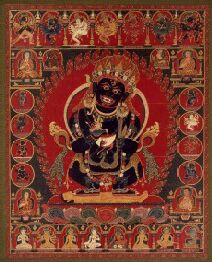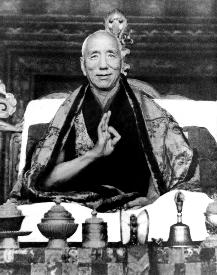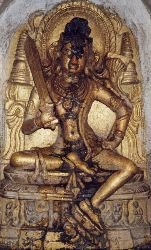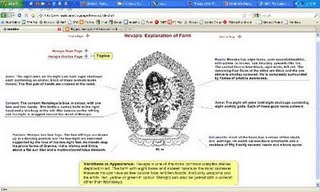Panjarnata Mahaka: An Exceptional Painting
 The image of the painting shown here is really quite exceptional. It may not be to everybody's taste. The style is very strongly influenced by the Newar aesthetics of the Kathmandu Valley. This style was also very popular at the Ngor Ewam Monastery of Ngorchen Kunga Zangpo. Ngorchen is depicted in the upper left corner below the image of the meditational deity Kalachakra.
The image of the painting shown here is really quite exceptional. It may not be to everybody's taste. The style is very strongly influenced by the Newar aesthetics of the Kathmandu Valley. This style was also very popular at the Ngor Ewam Monastery of Ngorchen Kunga Zangpo. Ngorchen is depicted in the upper left corner below the image of the meditational deity Kalachakra.
This painting is both unique and special, not because it is so clear and easy to follow, but rather because it represents precisely the form of Mahakala, a rare form, described in the Vajrapanjara Tantra. It also includes so many other deities described in that same tantra, deities special to the Hevajra system of practice - such as White Prajnaparamita, Yellow Vajra Tara, Bhutadamara Vajrapani, etc.
Panjarnata, Vajra Mahakala (Tibetan: dor je nag po chen po, gur gyi gon po. English: the Great Vajra Black One, Lord of the Pavilion), special protector of the Hevajra cycle of teachings and adopted as the principal protector of the Sakya Tradition of Tibetan Buddhism. This form of Mahakala arises from the 18th chapter of the Vajrapanjara exclusive explanatory tantra. The Vajrapanajara Tantra is exclusive to the Hevajra Root Tantra whereas a tantra such as the Samputa is an explanatory tantra shared between the Hevajra and Chakrasamvara (and Yogini) root literature.
Panjarnata Masterworks | Panjarnata Main Page | Panjarnata Outline Page
 The unique iconographic feature of Panjaranata Mahakala as described in the Vajrapanjara Tantra and according to the special Lamdre literature of the Sakya Tradition is that he has no ghandi stick laying horizontally across the forearms. In the other more common Sakya traditions of Panjara Mahakala, such as the Three Deity, Eight Deity etc., he is generally depicted with the ghandi 'stick of emanation.' There are other exceptions to this ghandi stick rule but they are rare and not commonly found in art. The two main exceptions are for the Nagarjuna lineage form and the Ngog lineage form of Panjarnata.
The unique iconographic feature of Panjaranata Mahakala as described in the Vajrapanjara Tantra and according to the special Lamdre literature of the Sakya Tradition is that he has no ghandi stick laying horizontally across the forearms. In the other more common Sakya traditions of Panjara Mahakala, such as the Three Deity, Eight Deity etc., he is generally depicted with the ghandi 'stick of emanation.' There are other exceptions to this ghandi stick rule but they are rare and not commonly found in art. The two main exceptions are for the Nagarjuna lineage form and the Ngog lineage form of Panjarnata.
As with most things related to Tantric Buddhism, there is some confusion regarding the name of this Mahakala. Specifically, the name 'panjara' or 'panjarnata' is referring to deities described in the Vajrapanjara Tantra. Therefore this form of Mahakala is the Vajrapanjara or Panjara form. However, generally speaking, there are other descriptions of this same form of Mahakala found in other tantras such as the Twenty-five Chapter and Fifty Chapter Mahakala Tantras. So, how are we to understand this?
Now it comes down to appearance. If the Mahakala form has one face and two hands, squat, holding a curved knife and skullcup at the heart, and generally (but not always) holding a ghandi stick across the forearms, then it is said colloquially and in Tibetan literature that this is Panjaranata Mahakala, or the panjara form of Mahakala despite the original source text. It is likely that this came about because the Vajrapanjara Tantra and the Hevajra Tantra were so well known as early Tantric literary works and practice traditions. Because the panjara name was so well known and represented the one face, two armed, form of Mahakala, it is therefore most likely that the name panjara came to be applied to all forms of Mahakala that had this same appearance.
Alternate Names: Vajra Panjara, Vajra Panjarnata, Panjara, Panjarnata, Panjara Mahakala, Panjarnata Mahakala.


 The Shelley & Donald Rubin Foundation has started a new website called the
The Shelley & Donald Rubin Foundation has started a new website called the 

















